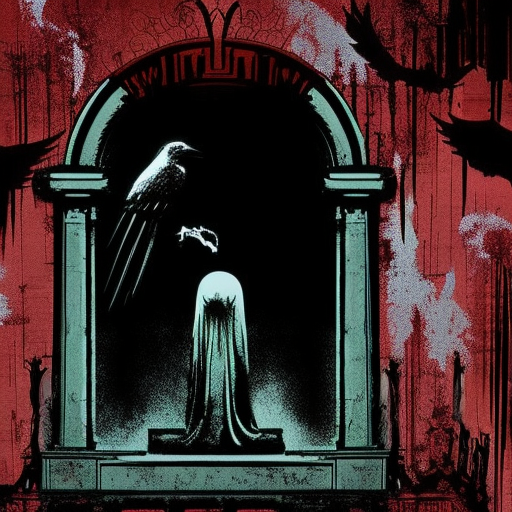The Raven: A Haunting Tale of Love and Loss
In Edgar Allan Poe’s classic poem, “The Raven,” a grieving narrator is visited by a mysterious raven that slowly drives him to madness. Through its haunting verses, the poem explores themes of love, loss, and the torment of the human mind.
A Grief-Stricken Narrator
The poem begins with a sorrowful narrator, who is mourning the loss of his beloved Lenore. The narrator is described as weak and weary, seeking solace in his books and trying to distract himself from his overwhelming grief. However, his attempts are in vain, as he is unable to forget his lost love.
The Arrival of the Raven
As the narrator sits alone in his chamber, he hears a tapping at his door. When he opens it, he finds nothing but darkness. He then hears a tapping at his window and, to his surprise, a raven flies into his room. The raven perches upon a bust of Pallas, the goddess of wisdom, and becomes a constant reminder of the narrator’s sorrow.
The narrator engages in a conversation with the raven, asking it questions about the afterlife and whether he will ever be reunited with Lenore. The raven’s response, a single word, “Nevermore,” becomes increasingly tormenting to the narrator, as it seems to confirm his worst fears and extinguish any hope of finding solace.
The Descent into Madness
As the poem progresses, the narrator’s mental state deteriorates. He becomes obsessed with the raven and its ominous presence. He starts to question his own sanity, wondering if the bird is a messenger from the underworld or a figment of his imagination. The raven’s constant repetition of “Nevermore” taunts the narrator, pushing him further into madness.
The narrator’s desperation reaches its peak when he asks the raven if there is any respite from his sorrow. The raven’s response, “Nevermore,” sends the narrator into a frenzy, as he interprets it as a confirmation that he will never find relief from his grief.
In the final stanza, the narrator resigns himself to his fate, accepting that he will forever be haunted by the raven and his own sorrow. He acknowledges that his soul will be trapped in the shadow of the bird, and he will never find peace.
Key Takeaways:
- Grief can consume a person, leading to obsession and madness.
- Loss can make one question their own sanity and search for meaning in the supernatural.
- The repetition of “Nevermore” serves as a reminder that some sorrows are eternal and cannot be escaped.
“And the Raven, never flitting, still is sitting, still is sitting, on the pallid bust of Pallas just above my chamber door; And his eyes have all the seeming of a demon’s that is dreaming, And the lamp-light o’er him streaming throws his shadow on the floor; And my soul from out that shadow that lies floating on the floor Shall be lifted—nevermore!”
In this memorable quote, the narrator describes the raven’s presence and the effect it has on his soul. The imagery of the raven as a demonic figure and the shadow it casts symbolize the narrator’s descent into madness and his inability to escape his grief.
“The Raven” is a haunting exploration of the depths of human sorrow and the toll it can take on one’s sanity. Through its vivid imagery and melancholic tone, the poem leaves a lasting impression on readers, reminding them of the power of grief and the torment of the human mind.












